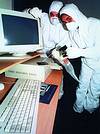

A procedure discovered by university scientists in co-operation with police uses a new application of genetic technology to recover minute samples invisible to the naked eye that have been left at a crime scene.
It was developed by South London University researchers along with the City of London Police. It uses a new application of DNA (deoxyribonucleic acid) technology to recover almost invisible samples left at a crime scene for examination.
The research team from South Bank University - led by Senior Lecturer in Forensic Science, Dr Nicholas Lemos, who instigated the project idea - worked closely with institutions in the City of London, the capital's international financial centre and its area police after a series of multimillion pound computer equipment thefts.
Members of the research team observed a strict protocol designed to avoid any contamination by wearing protective clothing from head to toe while working at crime scenes in offices.
They swabbed the surrounding area with cotton buds to recover samples invisible to the naked eye. During the investigation, minute traces left on computers and nearby may include skin brushing against a surface or from a few cells deposited through speaking and breathing. These can be positively identified and checked against the DNA database.
When the test samples were submitted to the Forensic Science Services and analysed using the super-sensitive DNA low copy number technique, profiles identifying the DNA donor were successfully obtained from 50% of the cases. This was significantly higher than previously obtained success rates of about 30%.
© Technews Publishing (Pty) Ltd. | All Rights Reserved.